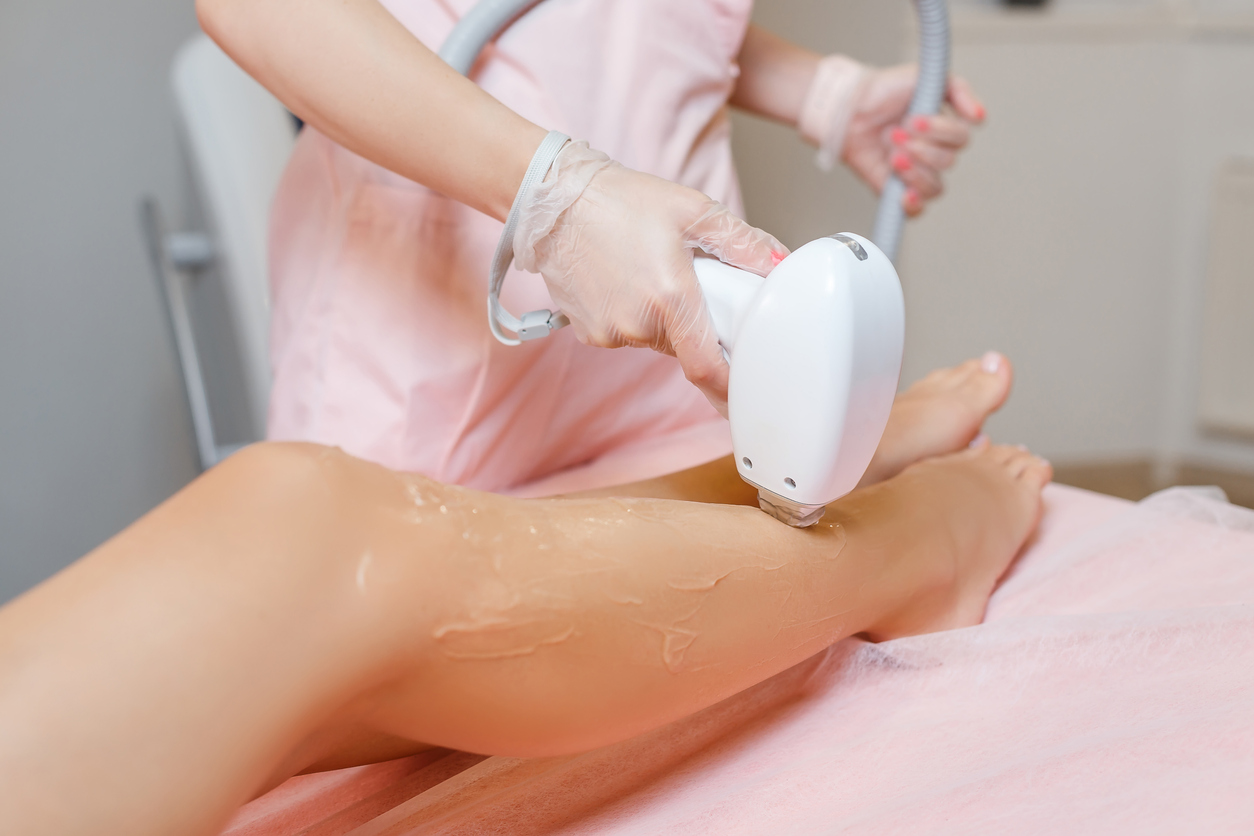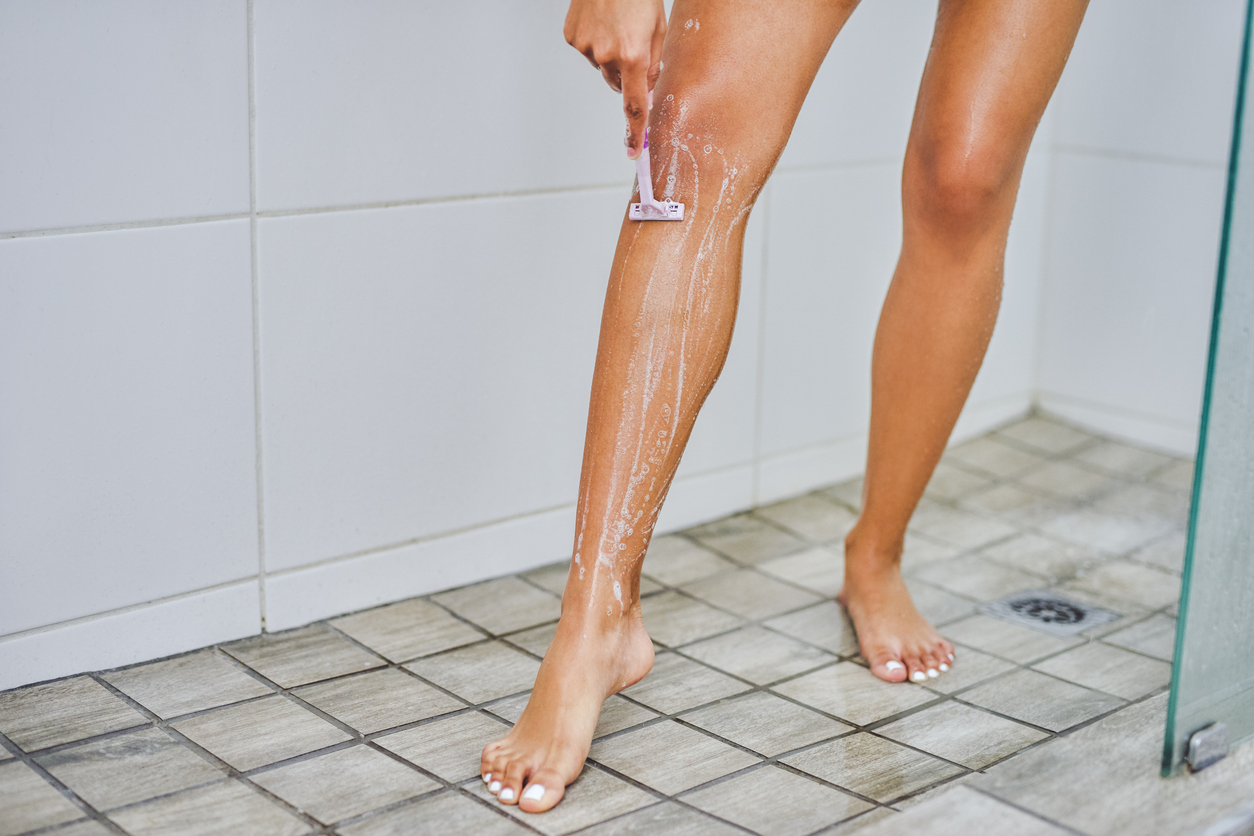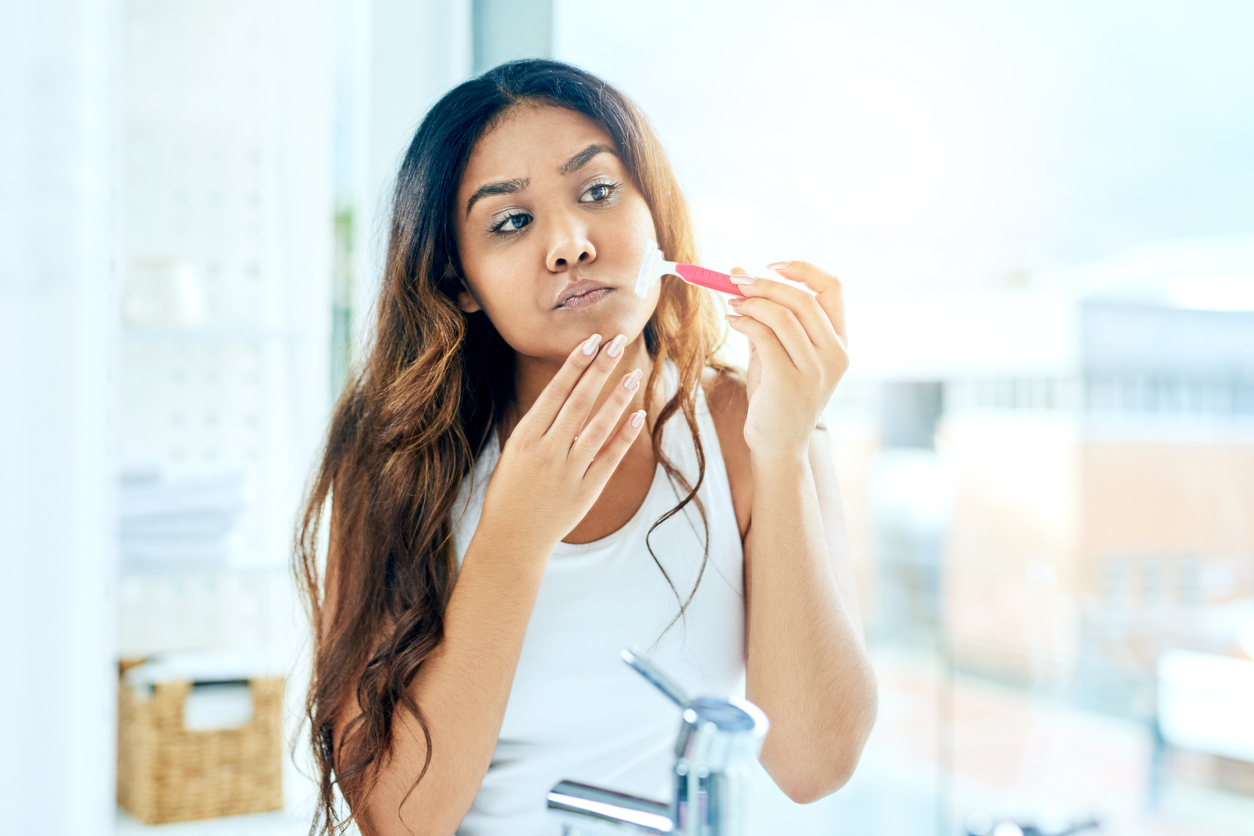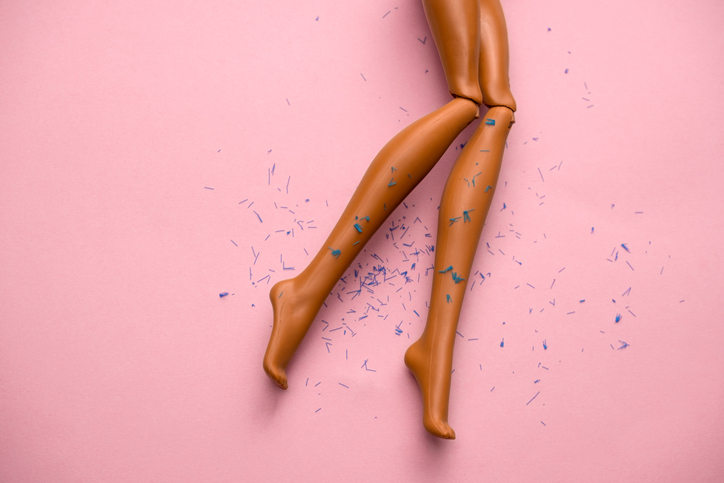What is rosacea?
Rosacea is a common but poorly understood long-term (chronic) skin condition that mainly affects the face. Symptoms begin with episodes of flushing (when the skin turns red).
As rosacea progresses, other symptoms can develop such as:
- burning and stinging sensations
- permanent redness
- spots (papules and pustules)
- small blood vessels in the skin becoming visible
In the most severe cases, skin can thicken and enlarge, usually on and around the nose.
Learn more about the symptoms of rosacea.
See your doctor if you think you have rosacea as early treatment helps reduce the chance of severe symptoms.
Triggers of rosacea
While the exact cause of rosacea is unknown, several triggers have been identified that may make the condition worse.
These include:
- exposure to sunlight
- stress
- exercise
- cold weather (wind)
- heat
- the menopause
- certain medications, such as vasodilator drugs
- hot drinks
- alcohol and caffeine
- eating certain foods, such as spicy foods
Identifying and avoiding the triggers of rosacea can be a useful way of controlling the symptoms.
Read more information about preventing rosacea.
Treating rosacea
There is no cure for rosacea, but treatments are available to control symptoms.
Rosacea is a chronic and relapsing condition, which means there are periods when symptoms are particularly bad, followed by periods when the condition is less severe.
As well as avoiding known triggers, certain medicines can help control flare ups.
Read more about treating rosacea.
As rosacea can affect your appearance, some people find they experience feelings of low self-esteem or frustration. You should speak to your doctor if you are feeling depressed.
Read about complications of rosacea for information on the psychological effects of having a long-term condition.
Who is affected?
Rosacea appears to be quite common, and is estimated to affect up to one in 10 people. It most commonly affects people with fair skin, but can also occur in people of Asian and African origin.
Rosacea occurs in both men and women and may occur at any age. However, it typically begins after the age of 30. Middle-aged women are more at risk due to hot flushes caused by the menopause.
Rosacea symptoms
Symptoms of rosacea often vary. Although the condition has a number of common symptoms, not everyone will experience all possible symptoms.
Common symptoms include:
- flushing
- persistent redness
- papules and pustules
- visible blood vessels
- thickened skin
- eye irritation
These symptoms are explained below.
Flushing (transient redness)
Flushing (when your skin turns red) is usually the first sign of rosacea, often dating back to childhood or early teens. Episodes of flushing can last up to five minutes.
In adult life, flushing is often caused by rapid changes of body temperature. This can be caused, for example, by sun exposure, hot drinks or exercise.
The flush can spread to your neck and chest, and you may experience an unpleasant feeling of heat.
Persistent facial redness
Persistent facial redness is the most common sign of rosacea. This redness is like a blush or a patch of sunburn that does not go away, or the sort of blotchy skin often associated with drinking too much alcohol.
This can be upsetting for people with rosacea as people can mistakenly assume they are heavy drinkers.
The redness usually affects the cheeks, nose and chin but may spread on the forehead, neck and chest. The skin may sometimes appear dry, scaly or swollen.
Visible blood vessels
If you have rosacea, you may experience inflammation of small blood vessels in the surface of your skin.
This can cause your skin to appear red and eventually the vessels become permanently dilated and visible (thread veins). The medical name for visible blood vessels is telangiectasia.
Papules and pustules
If you have rosacea, you may develop:
- papules – round red bumps that rise from your skin
- pustules – pus-filled swellings
These spots will appear on your face and are similar to teenage acne. Rosacea used to be called 'acne-rosacea' but the two conditions are quite different.
In rosacea there are no blackheads (small blocked pores)and the skin is not greasy but dry and peeling. Rosacea spots also do not cause scarring.
Thickened skin
In the most serious cases of rosacea, the skin can thicken and form excess tissue, usually around the nose. This causes the nose to take on a large, bulbous appearance. This is known as rhinophyma.
Rhinophyma is a rare, extreme symptom of rosacea and takes several years to develop. When it does occur, it is usually more common in men than women.
Eye irritation
Over half of people with rosacea also experience symptoms that affect their eyes, such as:
- feeling like there is something in your eyes
- dry eyes
- sensitivity to light (photophobia)
- irritated and bloodshot eyes, which often leads to related eye conditions such as blepharitis (inflammation of the eyelids)
Read more information about complications of rosacea.
Rosacea that affects the eyes is known as ocular rosacea.
Other symptoms
Other symptoms associated with rosacea include:
- a burning or stinging sensation on your face
- dry, rough skin
- raised red patches, known as plaques, on your skin
- facial swelling
- not being able to use cosmetics because your skin is sensitive to them
Most people with rosacea have periods when their symptoms are particularly troublesome, followed by periods where their symptoms are less problematic.
Permanent damage to the face, such as scarring, almost never occurs in rosacea.
Rosacea causes
The exact cause of rosacea is unknown. However experts think it may be caused by a number of related factors.
These factors are outlined below.
Blood vessel abnormalities
Many dermatologists (skin specialists) believe that abnormalities in the blood vessels of the face may be a major contributing factor for rosacea. This may explain symptoms of flushing, persistent redness and visible blood vessels.
It is not known what causes these abnormalities. However, damage of the skin matrix (collagen) by sunlight may be responsible for dilation of skin vessels which leads to redness, thread veins and inflammation.
Demodex folliculorum
Demodex folliculorum is a microscopic mite (tiny insect) that may contribute to rosacea. These mites usually live harmlessly on human skin, but higher numbers of mites have been found on people with rosacea. However, it is uncertain whether the mite is a cause or an effect of rosacea.
Helicobacter pylori bacteria
Helicobacter pylori bacteria, found in the digestive system, have been suggested as a possible cause of rosacea, although the link is not proven. The bacteria may stimulate production of a protein called bradykinin, known to cause blood vessels to expand.
Chemicals and ngested agents
Alcohol, caffeine, hot beverages, spicy foods, and medicines (such as amiodarone, topical steroids, oral steroids, and high doses of vitamins B-6 and B-12) may trigger flushing in patients with rosacea. However, there is no good quality evidence to support these factors as a cause of rosacea.
Genetics
Rosacea seems to run in families. However, it is not known which genes are involved or how they are passed on.
Triggers of rosacea
Most people who have rosacea notice certain triggers make their symptoms worse. Different people can have different triggers, but most commonly reported ones include:
- exposure to sunlight
- stress
- hot weather
- exposure to wind
- strenuous exercise
- alcohol
- hot baths
- cold weather
- spicy foods
- humidity
- caffeine (found in tea, coffee and cola)
- dairy products
- acute (short-term) medical conditions, such as a cold or fever (high temperature)
- chronic (long-term) medical conditions, such as high blood pressure (hypertension)
- vasodilatory medicines, which are often used to treat high blood pressure
Rosacea diagnosis
See your doctor as soon as possible if you think you have rosacea. Early treatment will prevent more serious symptoms of the condition, such as thickened skin, developing.
There is no specific clinical test for rosacea. Your doctor will make a diagnosis by:
- examining your skin
- asking about your symptoms
- asking about possible triggers you may have
In some circumstances, your may recommend you have further tests, such as a blood test, to rule out other conditions with similar symptoms, such as:
- lupus, a condition where the immune system (the body’s natural defence against infection and illness) attacks healthy tissue
- the beginning of the menopause (when a woman’s monthly periods stop)
In rare cases, a skin biopsy (a small scraping of skin) may be needed to rule out other possible causes such as:
- microscopic skin mites (Demodex folliculorum)
- skin infections
- rare skin conditions that may resemble rosacea
Treatment for rosacea
Rosacea can be treated in a number of ways.
Lifestyle changes
The initial treatment for rosacea is to avoid known triggers, or factors that make symptoms worse. These factors can be unique to every individual but the most important step is to avoid exposure to the sun.
Read more information about preventing rosacea.
Medication
A range of topical (skin-based) and oral (taken by swallowing) treatments have been used for rosacea.
They are effective mainly for treating inflammatory types of rosacea (papules and pustules). There is little evidence to support their use for the vascular form of rosacea (flushing, redness and thread veins). This is best treated with laser and light-based therapies (see below).
For mild rosacea, topical treatment agents include metronidazole, azelaic acid and sodium sulfacetamide-sulfur. Second line therapies include benzoyl peroxide, clindamycin, topical retinoids and calcineurin inhibitors.
For patients with moderate-to-severe rosacea or those with affected eyes (ocular rosacea), combination therapy with oral and topical agents is often needed. Options include tetracyclines and erythromycin. In severe cases, low dose isotretinoin may be effective.
Metronidazole
Metronidazole cream or gel (topical metronidazole) is usually recommended for the treatment of mild to moderate spots and pimples.
When applying metronidazole cream or gel, be careful not to get any in your eyes or mouth. You will need to apply topical metronidazole once or twice a day for several months.
Metronidazole does not usually cause side effects, although it may irritate your skin. This is usually more common with gels that contain alcohol. Avoid exposure to strong sunlight or UV light (used in some lamps and nightclubs).
Azelaic acid
An alternative to topical metronidazole is [ acid. Azelaic acid helps unblock pores and reduce inflammation (redness and swelling).
You will need to apply azelaic acid cream or gel twice a day, and avoid contact with your mouth and eyes. As with topical metronidazole, you may need to use azelaic acid for several months before you notice any significant improvement in your symptoms.
The side effects of azelaic acid can include:
- burning and stinging of the skin
- itchiness
- dry skin
About a third of people who use azelaic acid will experience side effects. However, any side effects are usually short-lived.
Antibiotic medicines
For more serious symptoms of spots and pimples, oral antibiotics may be recommended. In this case, antibiotics are used for their ability to reduce inflammation of the skin rather than their ability to kill bacteria.
As with other treatments, you will need to take oral antibiotics for several weeks before you notice a significant improvement in your symptoms. You may need to continue the course once or twice a day for several months or longer.
Long-term use of antibiotics should be avoided. One potential strategy is to gradually lower the dose of oral antibiotics after six to 12 weeks, eventually switching to topical agents only. A new technique is to use daily doxycycline given at a low dose, which may reduce inflammatory lesions when given alone or in combination with metronidazole therapy.
The two antibiotics that are most commonly used to treat rosacea are:
- tetracyclines
- erythromycin
Tetracyclines
These include tetracycline, oxytetracycline, doxycycline, lymecycline and minocycline.
Tetracyclines are not suitable for:
- women who are pregnant or breastfeeding, as they can cause birth defects in unborn children and interfere with normal bone development in breastfed children
- people with a history of kidney disease
Tetracyclines should be used cautiously in people with:
- a history of liver problems
- myasthenia gravis, a condition that causes weakness in some muscles
- systemic lupus erythematosus, a condition where the immune system (the body’s natural defence system) attacks healthy tissue
Tetracyclines may cause oral contraceptives (the contraceptive pill) to fail during the first few weeks of treatment. Sexually active women of childbearing age should use a barrier method of contraception while taking tetracyclines, such as a condom, to avoid becoming pregnant.
Tetracyclines can also make your skin more sensitive to sunlight.
Tetracyclines can interact with a number of medications, including:
- warfarin, an anticoagulant (blood-thinning medicine) used to stop your blood clotting
- antacids, taken to treat indigestion and heartburn
Erythromycin
Erythromycin can be used in women who are pregnant or breastfeeding. It should be used cautiously if you have:
- a history of liver or kidney problems
- myasthenia gravis, a condition that causes some of your muscles to become weak
Erythromycin can interact with a number of medications, including:
- warfarin, an anticoagulant (blood-thinning medicine) used to stop your blood clotting
- statins, taken to lower your cholesterol levels
Isotretinoin
Isotretinoin is a medicine often used to treat severe acne. However, at low doses it is also occasionally used to treat rosacea. As isotretinoin is a strong medication, it can only be prescribed by a dermatologist (an expert in treating skin conditions) and not your doctor.
Isotretinoin can cause side effects, including:
- birth defects in unborn babies
- dry skin, lips and eyes
- headaches
- back pain
- muscle or joint pain
- bleeding and bruising more easily
- blood in your urine
See the patient information leaflet that comes with your medicine for a full list of side effects.
Laser and intense pulsed light (IPL) treatment
The symptoms of redness and visible blood vessels (thread veins, telangiectasias) can be successfully improved with vascular laser or intense pulsed light (IPL) treatment. These treatments may also improve flushing.
Laser and IPL machines produce narrow beams of light that are aimed at the visible blood vessels in the skin. The heat from the lasers damages the dilated (widened) red veins and causes them to shrink so they are no longer visible, with minimal damage to surrounding tissue or scarring. There is evidence that the light also helps with remodelling of the skin matrix so it provides vessels with better support.
Laser treatment can cause pain, but most people do not need an anaesthetic.
Side effects of laser treatment are usually mild and can include:
- bruising
- crusting of the skin
- swelling and redness of the skin
- blisters (in rare cases)
- infection (in very rare cases)
These side effects usually only last a few days and are rarely permanent. An infection will require treatment with antibiotics.
Make-up
It may be possible to disguise patches of persistent red skin using specially designed 'camouflage' make-up.
Surgery
Thickened skin (rhinophyma) is a symptom of rosacea that often affects the nose. If you have severe rhinophyma, your doctor may refer you to a dermatologist or plastic surgeon.
Plastic surgery is not the same as cosmetic surgery. Cosmetic surgery is surgery carried out by choice (elective) and undertaken for the sole purpose of improving a person’s physical appearance. Plastic surgery is for repairing and reconstructing damaged skin and tissue.
A number of surgical treatments are available to remove any excess tissue and remodel the nose into a more pleasing shape. This may be done with:
- a carbon dioxide laser (a beam of carbon dioxide)
- a scalpel
- dermabrasion
Ocular rosacea
If the rosacea symptoms affect your eyes (ocular rosacea), you may require further treatment such as:
- ocular lubricants – eye drops or eye ointment which can be used to treat dry eyes
- eye hygiene measures – if you have blepharitis (inflammation of the eyelids), you may need to clean your eyelids with a warm compress (a cloth warmed with hot water) or cotton bud
- long-term oral antibiotics may be used in severe cases
People who have ocular rosacea with complications will need referral to an opthalmologist (eye specialist).
Read about treating dry eye syndrome and treating blepharitis.
Prevention
You can take steps to prevent your symptoms of rosacea from flaring up.
Avoiding triggers
Avoiding known triggers can help reduce the severity and frequency of your rosacea symptoms. To establish what triggers your symptoms, you could keep a daily diary of your activities.
Advice about how to avoid common triggers of rosacea is explained below.
Sunlight
As sunlight is the most commonly reported trigger of rosacea, you should use sunscreen every day, even when it's overcast.
A sunscreen cream with a sun protection factor (SPF) of at least 30 is recommended. A broad-spectrum sunscreen that protects against UV-A and UV-B light should be used. Using sunscreens specifically designed for children may help reduce skin irritation.
During summer months, minimise your exposure to the sun, particularly in the middle of the day when the sun is hottest. However, remember sun can also be strong in the morning and evening, so take adequate precautions at these times as well.
To reduce your exposure to the sun:
- regularly apply sunscreen to your skin
- wear a wide-brimmed hat
Stress
After sunlight, stress is the second most reported trigger of rosacea. Successfully managing your stress levels can help control your symptoms.
You can reduce stress by:
- taking regular exercise
- eating a healthy, balanced diet
- getting the right amount of sleep
As strenuous exercise can trigger an outbreak of rosacea, a low-intensity exercise programme, such as walking or swimming, may be better than high-intensity activities, such as running or aerobics.
You may also want to try relaxation techniques, such as:
- deep breathing exercises
- meditation
- yoga
Food and drink
The most commonly reported food- and drink-related triggers are alcohol and spicy foods. You may want to completely remove these from your diet to see if your rosacea improves.
However, there are many other dietary triggers that can adversely affect some people with rosacea. Include information about how your diet affects your rosacea symptoms in your rosacea diary.
Cold weather
Covering your face and nose with a scarf can help protect your skin from cold temperatures and wind.
If you need to spend considerable time outside during cold weather, protect your face with a balaclava.
Skincare techniques
The advice below about skincare techniques may also help control your rosacea symptoms.
- Do not rub, scrub or massage your face. It can irritate your skin
- Gently clean your skin every morning and evening using a gentle, non-abrasive cleanser. Use soap-free cleansers with non-alkaline or neutral pH. Avoid scented soaps and alcohol-based skin cleansers
- Rinse your face with lukewarm water and allow skin to dry thoroughly before you apply medication or make-up
- Look for products suitable for sensitive skin; usually described as mild, hypoallergenic, fragrance-free and non-comedogenic (will not block pores)
- Use a moisturiser to soothe skin if it feels sore
- Avoid oil-based or waterproof cosmetics requiring solvents for removal. Use water-based make-up
- Be aware some gels have alcohol bases. Water-based skin products are now on the market and are kinder on the skin. They are usually known as creams and serums
- Avoid astringents, toners and other facial or hair products that contain ingredients that might irritate your skin, such as fragrances, alcohol, menthol, witch hazel, tea tree oil, eucalyptus oil, camphor, clove oil, peppermint, sodium lauryl sulphate and lanolin
- You may want to avoid anything on your skin that you aren’t sure of and then gradually reintroduce products once your symptoms have been treated and cleared
- Men may find that using an electric razor, rather than a blade, helps reduce skin irritation
- Some patients find that regular facial massage reduces lymphoedema
- Do not use steroid cream unless you are specifically instructed to by your doctor. It may make your symptoms worse
Complications
Rosacea can cause complications that affect you physically and psychologically.
Eye problems
Rosacea that affects your eyes (ocular rosacea) can lead to a number of eye conditions.
Blepharitis (inflammation of the eyelids) is the most commonly reported eye condition resulting from rosacea. It can usually be successfully treated by adopting a daily eye-cleaning regime and by using antibiotic tablets and creams.
Up to one in 20 people with rosacea may experience symptoms that affect their cornea (the clear outer layer at the front of the eyeball). This can:
- make your eyes bloodshot and watery
- cause scarring of your cornea
In severe cases, if not treated, ocular rosacea can lead to vision loss. Your doctor may refer you for treatment with an ophthalmologist (a doctor who specialises in eye conditions and their treatment or surgery).
Psychological and social effects
Any chronic (long-term) condition can have an adverse psychological effect, but rosacea can be particularly troublesome because it affects your appearance. This can change how you feel about yourself and how you interact with others.
Many people with rosacea have reported feelings of:
- low self-esteem
- embarrassment
- frustration
It is important to come to terms with the fact that you have a chronic condition which, although incurable, is controllable. Persevering with your treatment plan and avoiding your individual triggers are the best ways of controlling your rosacea symptoms.
As your physical symptoms improve, you will start to feel better psychologically and emotionally.
If you have rosacea, take comfort knowing you are not alone. There are millions of people, in the UK and across the world, living with the condition.
Speak to your doctor if you are feeling depressed as a result of your condition. They may recommend further treatment.





